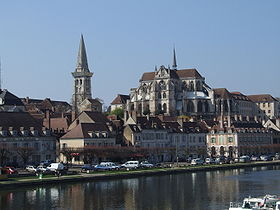
Abbey of Saint-Germain en Auxerre
Encyclopedia

Benedictine
Benedictine refers to the spirituality and consecrated life in accordance with the Rule of St Benedict, written by Benedict of Nursia in the sixth century for the cenobitic communities he founded in central Italy. The most notable of these is Monte Cassino, the first monastery founded by Benedict...
monastery in southern France, dedicated to its founder Saint Germain of Auxerre, the bishop of Auxerre, who died in 478. The abbey reached the apex of its cultural importance during the Carolingian
Carolingian
The Carolingian dynasty was a Frankish noble family with origins in the Arnulfing and Pippinid clans of the 7th century AD. The name "Carolingian", Medieval Latin karolingi, an altered form of an unattested Old High German *karling, kerling The Carolingian dynasty (known variously as the...
era; the source for its early history is an account of the Miracula Sancti Germani Episcopi Autissiodorensis ("Miracles of Saint Germain, Bishop of Auxerre") written before ca. 880. The earliest surviving architectural remains are also of the ninth century.
In 1927, beneath the 17th-century frescoed plaster walls of the crypt, were discovered ninth-century wall frescoes, the only surviving large-scale paintings of their date in France to compare to the illuminated manuscripts.
During the Revolution
French Revolution
The French Revolution , sometimes distinguished as the 'Great French Revolution' , was a period of radical social and political upheaval in France and Europe. The absolute monarchy that had ruled France for centuries collapsed in three years...
, several bays of the nave
Nave
In Romanesque and Gothic Christian abbey, cathedral basilica and church architecture, the nave is the central approach to the high altar, the main body of the church. "Nave" was probably suggested by the keel shape of its vaulting...
were demolished and the secularized abbey was used as a hospital. The former nave extended beneath the present forecourt.
In the late twentieth century the abbey's residential and service buildings were remodeled as a museum, presenting prehistoric, Gallo-Roman and medieval finds from Auxerre. An exhibition in 1990 brought the abbey's cultural impact into focus. The former abbey church remains in use for worship at stated times.

